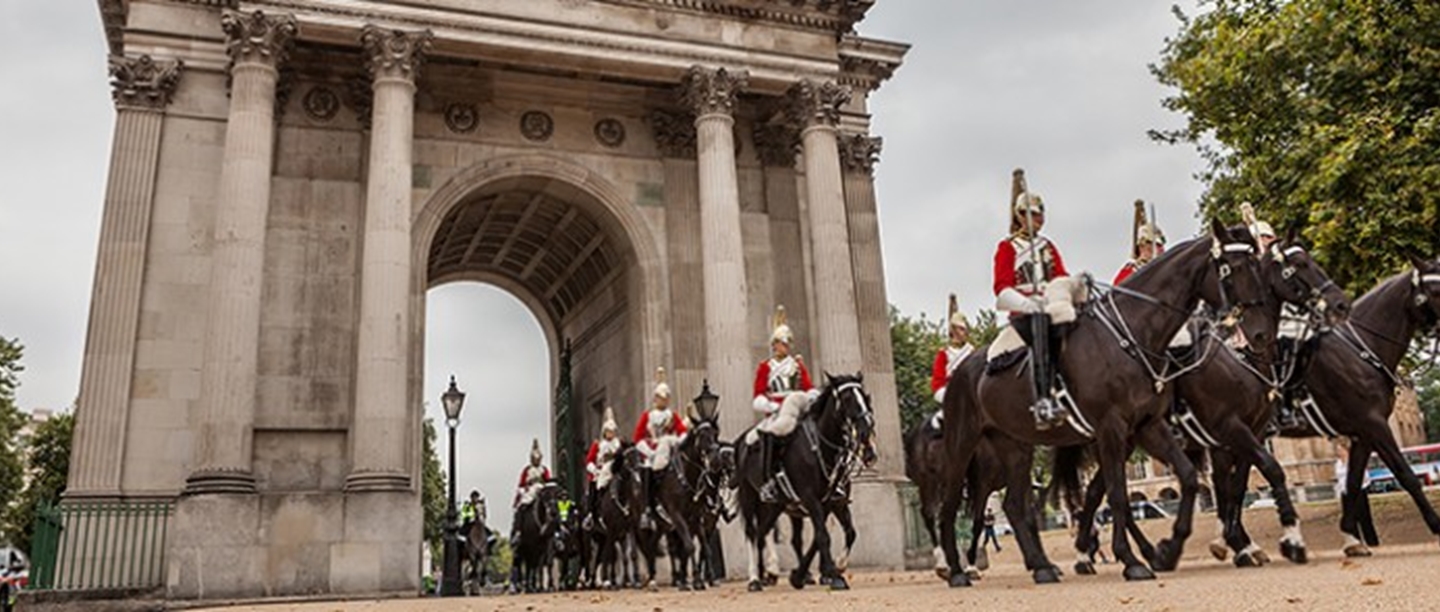
Britain’s approach to commemorating the nation’s dead began to change during the 19th century. Before the Victorian period, monuments were erected to celebrate national victories and honour officers and commanders.
After the Boer War (1899-1902) though, it became very noticeable that it wasn’t just officers being remembered. Particularly after the devastation of the First World War, memorials were erected as the focus for people’s grief.
The story of martial commemoration in London is explored in more detail in a new guidebook to Wellington Arch, Marble Arch and Six Great War Memorials which we’ve just published – the facts below are taken from there.
1. THE ARCHES WERE ONCE USED BY THE POLICE
London’s Metropolitan Police worked out of both Wellington Arch and Marble Arch. Until it was closed in 1959, Wellington Arch was London’s (and Britain’s) smallest permanently-manned police station. Marble Arch was a subsidiary post – the police would patrol Hyde Park, and any events taking place there, from here.
2. ONE OF THE EARLIEST MEMORIALS OF WWI WAS TO A WOMAN
The memorial to Nurse Edith Cavell (who was executed by firing squad for her role in helping smuggle Allied soldiers and would-be recruits from Belgium to Holland) is one of the earliest of the First World War. It was commissioned by the Daily Telegraph soon after her execution in October 1915.
Cavell was painted as a martyr by Allied propagandists. Her final message ‘Patriotism is not enough. I must have no hatred or bitterness towards anyone’, was added later when the National Council of Women lobbied to have a less martial note included.
Detail of the Edith Cavell Memorial
3. THE QUADRIGA WAS SCULPTED BY A VET
Adrian Jones, sculptor of the Quadriga which now sits on top of Wellington Arch, trained as a vet and served in as a veterinary captain in the army.
The Quadriga (erected in 1912) replaced an enormous statue of the Duke of Wellington which now stands near the garrison church at Aldershot, the home of the Army. A much smaller replica stands nearby.
One of Jones’ assistants working on the clay model for one of the horses © Historic England
4. THE ROYAL ARTILLERY MEMORIAL IS THE ONLY MAJOR BRITISH MONUMENT WITH A STATUE OF A DEAD MAN
The Royal Artillery (the single largest unit in the British Army) suffered 49,076 fatalities were in the First World War, and almost 30,000 more people in subsequent combats.
The four bronze statues around the monument were sculpted by Charles Sargeant Jagger, a veteran infantry officer. They depict three living soldiers on the east, south and west sides and – uniquely – a recumbent corpse draped in an overcoat on the northern side.
Jagger insisted on the inclusion of the dead gunner, and the inscription below it, from Shakespeare’s Henry V was his suggestion.
Statue on the Royal Artillery Memorial
5. BELGIAN REFUGEES PAID FOR A MEMORIAL
The Belgian Gratitude Memorial (opposite Cleopatra’s Needle on the Embankment) is a tribute to Great Britain from the people of Belgium for the welcome that was given to refugees fleeing the German invasion of 1914.
6. WELLINGTON ARCH AND MARBLE ARCH ARE WAR MEMORIALS…BUT THEY WERE DESIGNED AS GATES
They commemorate Britain’s victory over Napoleonic France, but their stories are mixed up with urban regeneration and royal redevelopment.
Most of Britain’s city walls and gates had been demolished by the mid 18th century, and it was felt that London had lost the character of a traditional European city. Eventually, Hyde Park Corner (effectively the western entrance to London) was chosen as the site for an impressive archway doubling as a gateway and monument. This gate was originally called the Green Park Arch, but later became the Wellington Arch.
Marble Arch was part of George IV’s plan for turning Buckingham House into a palace. The gateway would be dually an impressive entrance to the royal residence and another victory monument, probably inspired by the Arc de Triomphe in Paris and the Arch of Constantine in Rome.
Wellington Arch with Apsley House in the background
7. AND THEY BOTH WERE ORIGINALLY IN DIFFERENT LOCATIONS.
Hyde Park Corner had become a traffic bottleneck by 1874 and the decision was taken to move Wellington Arch. It was rebuilt close to its original position at Hyde Park Corner but facing down Constitution Hill.
Marble Arch was moved at the request of Queen Victoria. It was rebuilt at the north east corner of Hyde Park (Cumberland Gate) in 1851.
8. THE WORD ‘CENOTAPH’ DERIVES FROM THE GREEK FOR ‘AN EMPTY TOMB’
9. THE CENOTAPH WAS ORIGINALLY TEMPORARY
The current Cenotaph is the second memorial on this site. The original was a temporary structure made of wood and painted canvas for the Peace Celebrations of July 1919. It was designed by Sir Edwin Lutyens OM (1869-1944) who also designed the second, permanent version in Portland Stone.
The Cenotaph
10. THE SCULPTOR OF THE MACHINE GUN CORPS MEMORIAL SET UP THE ‘TIN NOSE SHOP’
During WW1 Francis Derwent Wood (RA) who designed the Machine Gun Corps Memorial created bespoke prosthetic masks for disfigured soldiers.
The department he set up – the ‘Masks for Facial Disfigurement Department’ was known at the hospital as the ‘Tin Nose Shop’
Find out more
These facts were discovered in the English Heritage Red Guide to Wellington Arch, Marble Arch and Six Great War Memorials by Roger H Bowdler and Steven P Brindle (2016)